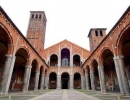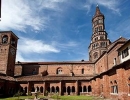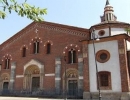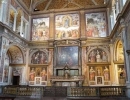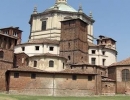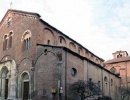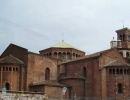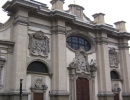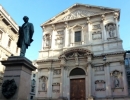THE MORE SIGNIFICANT BASILICAS, CHURCHES AND ABBEYS OF MILAN AND ITS TERRITORY
THE DUOMO OF MILAN
The never ending story
The story of the cathedral starts back 6 centuries ago. Learn all about it from its early century roots to its proper construction in the 14th century down to present day’s restoration.
THE BASILICA OF SANT’AMBROGIO
The most beautiful example of Romanesque architecture in northern Italy
Built in brick, according to Milanese tradition, the Basilica of Sant’Ambrogio with its sober profile inspires deep serenity. Founded by Ambrose in the IV century aD on an old burial ground, first dedicated to Martyrs, it was then turned into the prototype of Romanesque art along the centuries. See inside masterpieces such as Volvinio’s golden altar, a unique fruit of medieval jewellery shining in the middle of the presbytery right above the crypt where St Ambrose is at rest since his death in 397.
THE ABBEYS OF THE ‘LOWER LAND’
Lifestyle, architecture and art of the Cistercian and Humiliated monks.
Going through the fertile lands of the plain around Milan you’ll discover marvellous jewels of art and faith such as the abbeys of Chiaravalle and Viboldone. Wonderful brick architectures, precious 14th century frescoes, peaceful cloisters will help you getting an insight of the intense life of the monks.
THE BASILICA OF SANT’EUSTORGIO AND THE PORTINARI CHAPEL
This is among the most important churches of Milan, famous especially for the legend of the three kings whose bodies were brought in town by Eustorgio and were then stolen by Emperor Federico Barbarossa. Within the basilica, admire the splendidly frescoed chapel of Pigello Portinari, one of the first examples of Renaissance architecture that contains a famous marble tomb fully carved by Giovanni di Balduccio from Pisa in 1339.
SAN MAURIZIO AL MONASTERO MAGGIORE
A Milanese secluded-nuns monastery
Discover one of the most beautiful churches of 16th century Milan, home to the richest nuns’ community of the city with its annex Monastery. Don’t be misled by the simple and sober façade of the church of San Maurizio. Inside all the walls have been frescoed, thus turning the architecture into a precious artistic shrine.
THE BASILICA OF SAN LORENZO
This Basilica, with its still discussed central shape, more similar to a fortress than to a church because of the four bell towers that once surrounded it, brings us back in the early times of Christianity. In one of its chapels rare fragments of V century mosaics are to be seen.
THE BASILICA OF SAN SIMPLICIANO
Wanted by Ambrose in the IV century and first dedicated to the Virgin, San Simpliciano is a majestic basilica still bearing the traces of its old past; first built outside the town walls and in a very unsafe area, today it marks the entrance to one of the most beautiful and picturesque districts of the city. Visit also its remarkable cloisters, once belonging to the monk monastery that grew around the church and today seat of the Faculty of Theology.
SAN NAZARO IN BROLO
On the once arcaded street leading towards Rome, one of the most important Milan’s streets, Ambrose founded in the IV century, in a time when the city used to be the capital of Western Roman Empire, the Basilica Apostolorum to adequately deposit the relics of the Apostles. Subsequently also dedicated to San Nazaro, in the Middle Age the church takes its present Romanesque aspect. Just before entering it admire the funeral chapel designed by Bramantino in the early XVI century for Gian Giacomo Trivulzio, a Marshal of the French army.
SANTA MARIA AT SAN SATIRO
A medieval chapel, San Satiro; a church, Santa Maria, built on a devotional area visited by hundreds of pilgrims. Two distinguished structures that the genius of Bramante reunites in a highly spectacular way. Try to guess the depth of the apse that the architect has to come up with, given the presence of via Falcone, right behind the church.
SANTA MARIA DELLA PASSIONE
The biggest Milanese church after the Cathedral, it represents the perfect example of solemn Lombard Renaissance architecture. Its inside is preciously frescoed with episodes of the Passion of Christ, while in the capitular’s room of the annex convent, Bergognone left one of his best artistic cycles. See also the beautiful XVI century cloister, now part of the conservatoire Giuseppe Verdi.
THE CHURCH OF SAN FEDELE
Wanted by Cardinal Charles Borromeo and run by Jesuits, San Fedele became the model of counterreformation churches. Among the most valuable treasures of its inside see the wooden choir with its insertions in mother pearl and the confessionals, made in the last decades of the XVI century.
THE DUOMO OF MONZA
Work by Matteo da Campione, it stands on the VI century Lombard oraculum dedicated to St John the Baptist by queen Teodolinda. Old times are witnessed in the splendid treasure now on show in the annex museum. Inside the Duomo, in the magnificently frescoed chapel dedicated to queen Teodolinda, unique and absolute masterpiece of International Gothic painting, rests the famous Iron Crown, used, among others, by Napoleon for his election as king of Italy.


